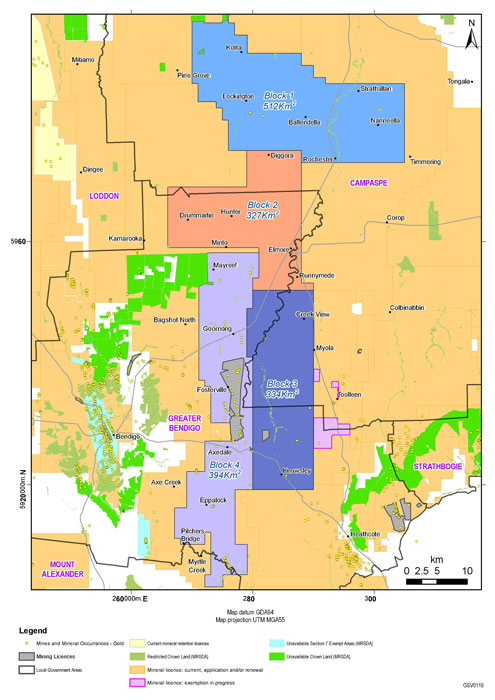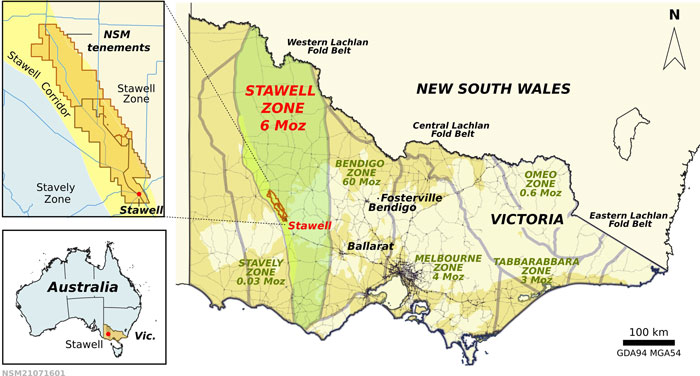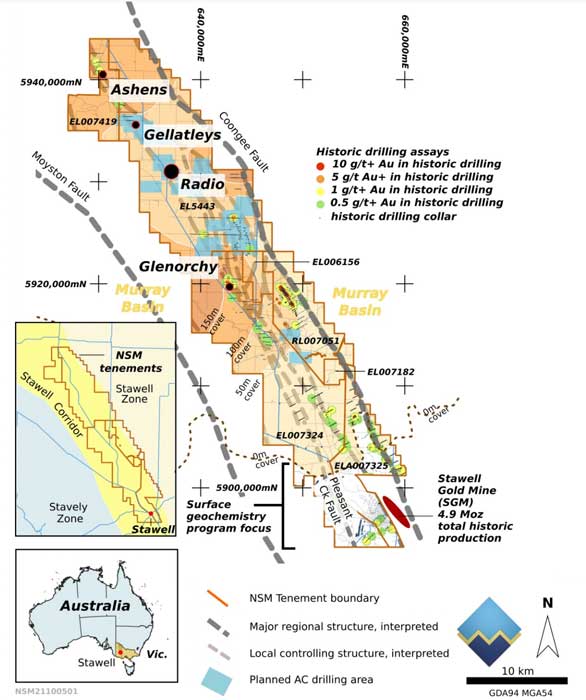Spotlight firmly on Victorian gold fields as explorers scramble; this junior has a head start

Pic: Bloomberg Creative / Bloomberg Creative Photos via Getty Images
The battle for ground in the highly fertile Victorian gold fields is intensifying and those already in the region and advancing exploration projects are ahead of the pack.
Not long after revealing another high-grade gold discovery at its Fosterville mine, Kirkland Lake Gold found itself a suitor, Agnico Eagle Mines, which has delivered the company a C$13.4bn all stock offer too good to refuse.
Meanwhile, the Victorian government last week revealed the winning tenders for its North Central Victorian Goldfields Ground Release, which comprises four blocks ranging from 327-512sqkm in size surrounding the high-grade Fosterville mine near Bendigo.

The winning tenderers were Kirkland Lake Gold and S2 Resources’ subsidiary Southern Star Exploration, which collectively plan to spend $100m searching for gold on Fosterville’s doorstep.
As veteran resources journalist Barry FitzGerald puts it: “Fosterville is one of the world’s most profitable gold mines thanks to the 2016 discovery of the Swan Zone with its two-ounce-a-tonne dirt.”
And there are still plenty more big discoveries to be made according to the Geological Survey of Victoria, which estimates there may be up to 75 million ounces of gold still to be found in the central and north central Victorian goldfields.
This very nearly matches the 80 million ounces of gold that has been mined from the area over the past 160 years.
But it’s not just the central and north central areas of these centuries-old goldfields that could be hiding the next Fosterville. Over to the west is the Stawell gold mine, which up until 2008 was Victoria’s top gold producer.
The Stawell mine was restarted a couple of years ago and the owners have identified the potential for a major expansion to production after uncovering extensive high-grade gold within the Magdala Basalt Dome.
The Stawell district, which is an historic goldfield dating back to the 1850s, is a key part of Victoria’s aptly named ‘Golden Triangle’. The Stawell Mineralised Corridor has so far yielded 6 million ounces of historical production.
“Victorian gold mining generally has had somewhat of a renaissance in recent years and Fosterville, Stawell and the like have featured fairly significantly in that renaissance,” Russell Krause, interim CEO of junior Victorian goldfields explorer North Stawell Minerals (ASX:NSM), told Barry FitzGerald in a recent Stockhead Explorers Podcast.
“I think that Victoria is well and truly on the map again, and … there’s now something like 30-odd explorers working in the area. So that says something must be going the right way.”
NSM, which is currently drilling at the Radio prospect in the Stawell Corridor, was spun out of Stawell Gold Mines to capitalise on the 550sqkm of exploration ground that hosts 51 strike kilometres of the Stawell Mineralised Corridor to the north-west of the Stawell mine.

NSM’s exploration to date has identified 20+ basalt dome targets, similar to the Magdala Dome structure that hosts the gold within the neighbouring Stawell mine, and other targets in the Stawell Corridor.
But before Stawell Gold Mines acquired the ground at the end of 2017, exploration had been sparse because any potential new discoveries were masked by shallow cover.
This is where the opportunity lies for modern day explorers.
By Geological Survey of Victoria estimates, there is around 38 million ounces of gold under cover in the northern part of the Stawell Zone, most of which relates to the Stawell Corridor.
The major findings of Geological Survey of Victoria’s Gold Undercover initiative were that the northern parts of western and central Victoria’s Stawell and Bendigo zones hold the greatest potential for gold, and this was likely to be at a depth within reach of modern drilling techniques.
“While the success of early explorers can be attributed to a mix of luck, enthusiasm and skill, Victoria’s current gold renaissance is the result of an in-depth understanding of the state’s unique geology and skilled workforce, cutting-edge advances in technology and more efficient mining techniques,” the geoscience agency said.
At the end of the September quarter, NSM kicked off a +20,000m regional drilling campaign on new and re-interpreted targets, initially at the Radio Hill prospect.
Drilling at Radio Hill is targeting a geophysical anomaly that was masked by 50m of cover but identified from a recent airborne gravity survey and reprocessed magnetics data. All holes drilled so far have reached their target beneath the cover.

“The Radio Prospect includes interpreted geology, structure and geophysics that make it prospective for mineralisation similar to the multi-million-ounce Stawell mine, 40km along strike to the southeast,” Krause said.
“The geology of the area indicates that Stawell Corridor, bound by a couple of major fault lines, has the potential and the geological occurrences to actually carry a significant number potentially of Magdala-type structures.”
Exploration across NSM’s ground in the September quarter identified 20 priority targets with geology and structures that match that of the Stawell mine. Eight of these targets have never been drill tested.
NSM has so far identified 30km of highly prospective strike under cover-dominated tenements.
“Over 80% of NSM’s ground is masked by this cover, but the underlying rocks and structures are similar to the Stawell gold mine,” Krause said.
“Effectively peering through this cover is critical to success and NSM’s work in recent quarters has yielded dramatic improvements in our ability to target through this cover.”
While the first batch of drill cores were only recently sent to the lab for assaying, all the signs are there that NSM could be about to uncover the next Stawell or Fosterville.
“We have seen just from the logging of the holes that we have encountered at the appropriate depths, according to the geophysical work that we’ve done, basalt intersections, quartz veining and all the things that look like they’re gold bearing anomalies,” Krause said.
“So, whilst we need to wait for the results and the confirmation, the initial work has our geological team quite excited about what they’ve seen, and we’re on the path to, I think, verifying some of the techniques that we’ve used in justifying their performance.”
Synergies with gold producer give NSM a leg up
NSM has effectively been established as the exploration arm of Stawell Gold Mines, with about 60% of its shareholding in common.
“Our offices are at Stawell Gold Mines, we share data where appropriate with Stawell Gold Mines and Stawell Gold Mines are currently in the process of looking at expanding their operations somewhat significantly, and they’re doing that in anticipation of exploration success both to the north and the south in that corridor,” Krause explained.
Another benefit of this close relationship is that NSM has a route to production in the event it makes a multi-million-ounce discovery.
“Should we be successful in finding a nice attractive target that can be turned into a mine very quickly, we do not have to go through the process of building a plant or anything like that,” Krause said.
“We simply have to get our permitting done for the mining operation and the plant is at Stawell and we are there to supply them with hopefully some good quality gold bearing ore.”
This article was developed in collaboration with North Stawell Minerals, a Stockhead advertiser at the time of publishing.
This article does not constitute financial product advice. You should consider obtaining independent advice before making any financial decisions.
Related Topics

UNLOCK INSIGHTS
Discover the untold stories of emerging ASX stocks.
Daily news and expert analysis, it's free to subscribe.
By proceeding, you confirm you understand that we handle personal information in accordance with our Privacy Policy.








